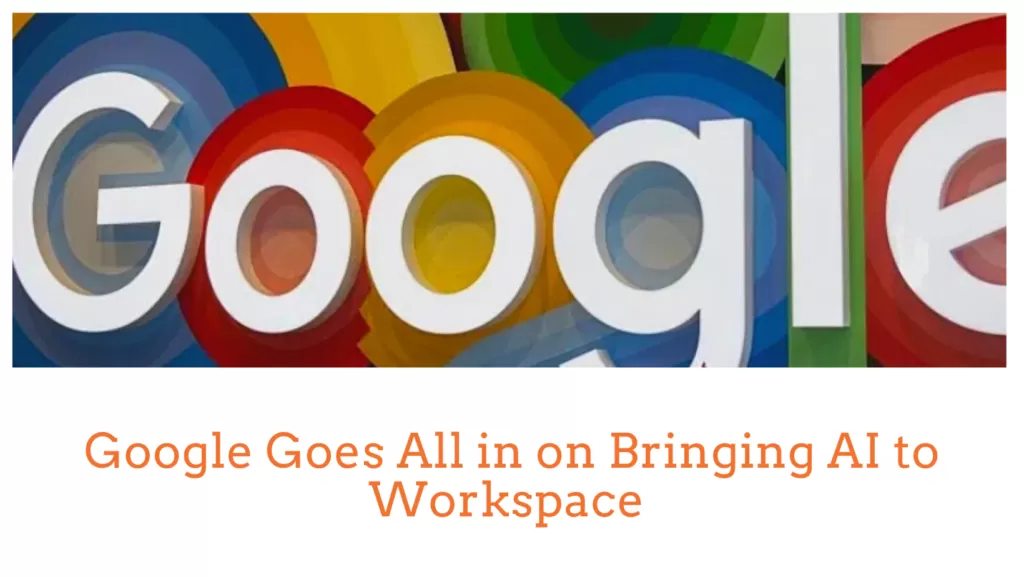
Google and Microsoft are locked in a head-to-head competition to bring as much generative AI to their productivity services as possible. Only days ahead of Microsoft’s “Future of Work” event, Google today announced a sweeping update to Workspace that will bring its generative AI models to virtually every part of its productivity suite, in addition to new developer solutions that will make Google’s foundation models, including its 540 billion-parameter PalM large language model for multiturn chats, available to developers through an API and new low-code tools.
The caveats worth mentioning up front: For the time being, these new features will only be available for what Google calls “Trusted Testers.” It’s unclear when they will roll out to a wider audience. There’s also no pricing information available yet, though it sounds like at least a subset of these features will be available to consumers — including those on Google One plans. Basically, this is akin to Google’s LaMDA announcements a few weeks ago: they sound great, but it’ll be a while before you can try any of this in practice.
Google’s plan is to bring its generative AI models to virtually every part of Workspace, be that writing emails for you in Gmail, helping you write (or rewrite) documents in Docs, formula generation in Sheets, capturing notes in Meet, or creating text, images, audio and video in Slides. If I had to take a guess, chances are Microsoft will announce very similar updates later this week.
“Google Workspace has been a longtime pioneer in enabling real-time collaboration, where human beings work together in real time in our products,” Google Cloud CEO Thomas Kurian said during a press briefing ahead of today’s announcements. “This next phase is where we’re bringing human beings to be supported with an AI collaborator who is working in real time in concert with them.”
Kurian said the company plans to rapidly roll out new features “every couple of weeks.” Throughout the year, trusted testers will get access to the first phase now, which will include getting help in writing emails in Gmail and documents in Docs. The core features here, for now, are getting help with writing and adjusting the tone and style of text. But as Google stressed, that’s just the start (at least for the Trusted Tester group).
The promise here is that Google will eventually infuse AI into virtually every workflow in Workspace. This may mean summarizing an email conversation or brainstorming a Docs document. Of course, because so much of this is chat-based, Google Chat will also get support for some of these features, but so far, Google has only said that it will “enable workflows for getting things done in Chat.”
Maybe the most impressive demo Google showed, though, was combining a lot of this text-based work with generative AI models for image and music generation — and using that to create a full-fledged presentation around it. “With Slides, we’re helping you generate insights and images from text in slides,” Kurian explained. “So you can use images from your rich content library, your brand images — if you’ve got your own company’s images — and private repositories, to generate these images and superpower every person building with slides, including generating soundtracks.”
When asked about pricing, Kurian noted that the company plans to make “these solutions available broadly to our enterprises, to small businesses, to consumers — and even to people who subscribe to Google One.” And that’s pretty much all we know for now, though the mention of Google One is an interesting one, given that Google has been pushing its subscription service — which offers additional cloud storage space as its main benefit — to slowly include more features over time, including its VPN Service.
82% off! .xyz domain at only $2!
Save up to 97% in Namecheap Solopreneur Sale!
Show your company is legit, from $36.88
It’s been no secret that Google was going all out with bringing generative AI to the widest possible range of its product. It’s just a bit of a shame that many of today’s announcements feel like vaporware, with only a select number of users getting access to it for now. And while features like Smart Compose and Smart Reply are obviously widely available (and quite useful) Google seemingly remains hesitant to put its latest AI technology into the hands of everyday users.
The strategy here, though, feels right. Google Workspace provides the largest canvas for the company to bring its various AI technologies to users and Gmail and Docs are the lowest-hanging fruit here, so it makes sense for Google to start there. It’s also where large text models shine, all while Google gets to sidestep the issues that Bing and ChatGPT face with their chatbots going off script (though Microsoft seems to have gotten this under control for now) and without any risk to its search business.




